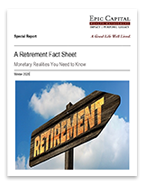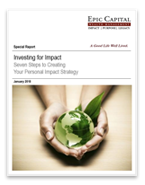Market Update: CPI Disappoints
Oct 14, 2022

Disappointing
The core Consumer Price Index (CPI), which excludes food and energy, rose to a multi-decade high in September, disappointing both investors and policy makers. The CPI is one, but not the only metric for inflation.
September headline inflation eased slightly to 8.2% year-over year from 8.3% in August. Energy commodity prices outright declined for the last three months, offsetting the accelerating price increases in other areas such as food and rent. Core inflation, which excludes food and energy, rose 6.6% from a year ago, the highest rate since 1982. The nagging pressure on core inflation will likely put pressure on the Federal Reserve (Fed) to stay aggressive in its fight.
Inflation is Unevenly Distributed
Not all categories experienced price increases. Gasoline and fuel prices fell for the third consecutive month and used car prices fell six out of the last eight months.
But other categories show persistent and potentially entrenched inflation pressures. Shelter costs were the largest contributor to headline inflation, adding 2.2 percentage points in September. Rent prices rose 18 out of the past 19 months, creating acute pain for those who didn’t participate in the recent home-buying surge.
Inflation continues to be driven by services such as medical care, insurance, and housing in contrast to the decelerating inflation in goods, especially durable goods as shown in the chart below.
Impacts on Consumers Are Mixed
Higher prices and slow wage growth will likely put pressure on consumers as purchasing power declines. We expect to see growing demand for credit and a drawdown in savings to support spending habits. Prices at the pump fell during the first half of September but reversed course and continued to increase into October, adding to the risk that the October CPI report will also disappoint.
Rising food and rent costs are a growing concern. These pressures are especially hurting lower income households where food and rent are a larger share of total spending.
Rising Rents Continue
Rents will likely continue to rise as the housing market rebalances after the post-COVID boom. Recent pricing trends for rent of primary residence is alarming. Rent prices are up 7.2% from a year ago, the fastest rate since the early 1980s. The massive reshuffling in the housing market explains most of the rise in rental costs. During the recent period of unusually low mortgage rates, housing demand skyrocketed and home price appreciation reached new levels. High housing costs pushed many homes out of reach for would-be millennial buyers and for first-time buyers with no pre-existing home equity. High demand for homes and low supply created insurmountable hurdles and pushed many to be renters instead of home buyers so it may be a while before rent prices cool.
Conclusion
Headline inflation is likely past its peak, but the Fed still has work to do. The Fed will likely increase rates again by 0.75% in November as core inflation is not cooling as fast as expected. A big risk for the Fed is inflation becoming entrenched in some sectors such as services as inflation cools in other sectors. Another risk is the unknown impacts of a strong dollar in the international currency markets. The US dollar will likely strengthen as the Fed keeps tightening in this uneven inflationary environment.
As import prices and producer prices ease, the inflation outlook should improve. As policy makers have publicly indicated, inflation is the primary concern and for now, the Fed is willing to sacrifice economic growth in the near term to get inflation back to the long-run rate of 2%. The path to a soft landing for the Fed continues to narrow. While avoiding a deep recession remains possible if the labor market holds up, the odds of recession continue to rise as the inflation fight gets more challenging.
IMPORTANT DISCLOSURES This material is for general information only and is not intended to provide specific advice or recommendations for any individual. There is no assurance that the views or strategies discussed are suitable for all investors. To determine which investment(s) may be appropriate for you, please consult your financial professional prior to investing. Investing involves risks including possible loss of principal. No investment strategy or risk management technique can guarantee return or eliminate risk in all market environments. For more information on the risks associated with the strategies and product types discussed please visit https://lplresearch.com/Risks References to markets, asset classes, and sectors are generally regarding the corresponding market index. Indexes are unmanaged statistical composites and cannot be invested into directly. Index performance is not indicative of the performance of any investment and do not reflect fees, expenses, or sales charges. All performance referenced is historical and is no guarantee of future results. Unless otherwise stated LPL Financial and the third party persons and firms mentioned are not affiliates of each other and make no representation with respect to each other. Any company names noted herein are for educational purposes only and not an indication of trading intent or a solicitation of their products or services. All information is believed to be from reliable sources; however, LPL Financial makes no representation as to its completeness or accuracy. Securities and advisory services offered through LPL Financial, a registered investment advisor and broker-dealer. Member FINRA/SIPC.
More Insights
Birthdays may seem less important as you grow older. They may not offer the impact of watershed moments such as getting a driver’s license at 16 and voting at 18. But beginning at age 50, there are several key birthdays that can affect your tax situation, health-care eligibility, and retirement benefits.
During times like these when geopolitical headlines can be unsettling for investors, we at LPL Research like to remind ourselves of one of our key investing principles. Markets have always faced challenges —ranging from geopolitical conflicts and economic downturns to natural disasters, political upheaval and health crises. These events often trigger short-term volatility and shake … Continue reading “Why Long Term Investing Beats Selling in Volatile Times”
Are you concerned about the inheritance taxes your heirs may have to pay? Then you may want to consider creating charitable lead trusts.
You’re beginning to accumulate substantial wealth, but you worry about protecting it from future potential creditors. Whether your concern is for your personal assets or your business, various tools exist to keep your property safe from tax collectors, accident victims, health-care providers, credit card issuers, business creditors, and creditors of others. To insulate your property … Continue reading “Estate Planning – Protecting Your Assets”
You know how important it is to plan for your retirement, but where do you begin? One of your first steps should be to estimate how much income you’ll need to fund your retirement. That’s not as easy as it sounds, because retirement planning is not an exact science. Your specific needs depend on your … Continue reading “Estimating Your Retirement Income Needs”
Services
Epic Capital provides the following comprehensive financial planning and investment management services: Learn More >



 Top of Page
Top of Page











